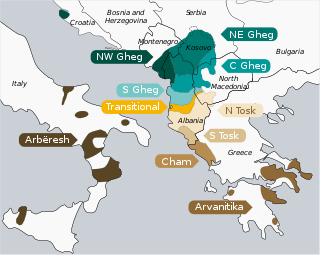Tosk Albanian
Appearance
| Tosk | |
|---|---|
| toskërishtja | |
| Region | Albania, Kosovo, North Macedonia, Italy, Greece, Turkey |
Native speakers | 1.8 million (2011 census)[1] |
Early form | |
| Dialects |
|
| Albanian Alpha bet,formerlyElbasan | |
| Language codes | |
| ISO 639-3 | als |
| Glottolog | alba1268tosk1239 |
| Linguasphere | 55-AAA-aca to 55-AAA-ace |
 A map showing Tosk speakers in the two palest shades of brown. | |
Tosk(Albaniandefinite form:toskërishtja) is the southern group of dialects of theAlbanian language,spoken by the ethnographic group known asTosks.The line of demarcation between Tosk andGheg(the northern variety) is theShkumbin River.Tosk is the basis of the standard Albanian language.
Major Tosk-speaking groups include the Myzeqars ofMyzeqe,Labs ofLabëria,ChamsofÇamëria,ArvanitesofGreeceand theArbëreshëofItaly,as well as the original inhabitants ofMandritsainBulgaria.InNorth Macedonia,there were approximately 3000 speakers in the early 1980s.[2]
Tosk features
[edit]This section shouldspecify the languageof its non-English content, using{{lang}},{{transliteration}}for transliterated languages, and{{IPA}}for phonetic transcriptions, with an appropriateISO 639 code.Wikipedia'smultilingual support templatesmay also be used.(August 2020) |
- Rhotacism:Proto-Albanian*-n-becomes-r-(e.g.rëra"sand" )
- Tosk dialects preserve groupsmb,ngjandndassimilated tom,njandninGheg.[3]
- Proto-Albanian*ōbecomesva.
- Nasal vowels: There is a lack of nasal vowels in Tosk (e.g.sy"eye" ) and Late Proto-Albanian*âplus a nasal becomesë(e.g.nëntë"nine" ).
- e-vowel: Theebecomesëin some varieties in some wordsqënforqenin Vjosë.
- ë-vowel: Theëmay have several pronunciations depending on dialect: theëis more backed in Labërisht dialects like that ofVuno,wheremëz"foal" is[mʌz]). Final -ë drops in many Tosk dialects and lengthens the preceding vowel.
- y-vowel: Theyvowel often derounds toiin Labërisht, Çam, Arvanitika and Arbëresh (e.g.dy"two" becomesdi).
- Dh and Ll: These sounds may interchange in some words in some varieties.
- H: This may drop in any position in some dialects.
- Gl/Kl: Some varieties of Çam, Arberësh, and Arvanitika retainklandglin place ofqandgj(e.g.gjuhë"tongue" isgluhëin Çam,gluhëin Siculo-Arberësh, andgljuhëin Arvanitika; "klumësh" for "qumësht" "milk" in Arbëresh).
- Rr:Rrbecomesrin some varieties.
Northern Tosk
[edit]Vowels
[edit]| Front | Central | Back | |
|---|---|---|---|
| Close | iy | u | |
| Close-mid | e | ||
| Open-mid | ɜ | ɔ | |
| Open | a |
| IPA | Description | Written as |
|---|---|---|
| i | Close front unrounded vowel | i |
| y | Close front rounded vowel | y |
| e | Close-mid front unrounded vowel | e |
| a | Open central unrounded vowel | a |
| ɜ | Open-mid central unrounded vowel | ë |
| ɔ | Open-mid back rounded vowel | o |
| u | Close back rounded vowel | u |
- Mid soundse,ocan also be heard as[ɛ,o],in free variation.[4]
See also
[edit]References
[edit]- ^ToskatEthnologue(18th ed., 2015)(subscription required)
- ^Fraenkel, Eran; Kramer, Christina Elizabeth (1993).Language Contact - Language Conflict.P. Lang. p. 36.ISBN9780820416526.
Thus, for example, even the small numbers of Tosk Albanians of southern North Macedonia (only approximately 3,000 in the early 1980s)
- ^Orel, Vladimir E. (1998).Albanian etymological dictionary.Leiden: Brill.ISBN9789004110243.
- ^Coretta, Stefano; Riverin-Coutlée, Josiane; Kapia, Enkeleida; Nichols, Stephen (16 August 2022)."Northern Tosk Albanian".Journal of the International Phonetic Association:1–23.doi:10.1017/S0025100322000044.hdl:20.500.11820/ebce2ea3-f955-4fa5-9178-e1626fbae15f.
External links
[edit]Tosk Albanian editionofWikipedia,the free encyclopedia
